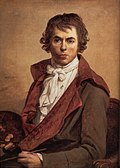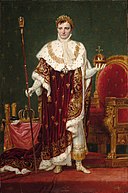File:Jacques-Louis David – Emperor Napoleon I (1769-1821) – Google Art Project.jpg
Appearance

Size of this preview: 402 × 599 pixels. Other resolutions: 161 × 240 pixels | 322 × 480 pixels | 515 × 768 pixels | 687 × 1,024 pixels | 1,374 × 2,048 pixels | 3,759 × 5,602 pixels.
Original file (3,759 × 5,602 pixels, file size: 5.79 MB, MIME type: image/jpeg)
File history
Click on a date/time to view the file as it appeared at that time.
| Date/Time | Thumbnail | Dimensions | User | Comment | |
|---|---|---|---|---|---|
| current | 16:33, 2 December 2022 |  | 3,759 × 5,602 (5.79 MB) | Stv26 | {{Artwork |wikidata = Q70781085 |artist ={{Creator:Jacques-Louis David}} |title ={{en|1=This portrait of Napoleon is believed to be the model for a larger composition, now lost. After his coronation in the Cathedral of Notre Dame on December 2, 1804, portraits like this one of the emperor in his ceremonial garb were commissioned and disseminated throughout Europe. Their main purpose was to establish an iconography of the emperor’s reign, which relied on royal conventions of sovereign... |
File usage
The following page uses this file:
Global file usage
The following other wikis use this file:
- Usage on ann.wikipedia.org
- Usage on de.wikipedia.org
- Usage on incubator.wikimedia.org
- Usage on www.wikidata.org




